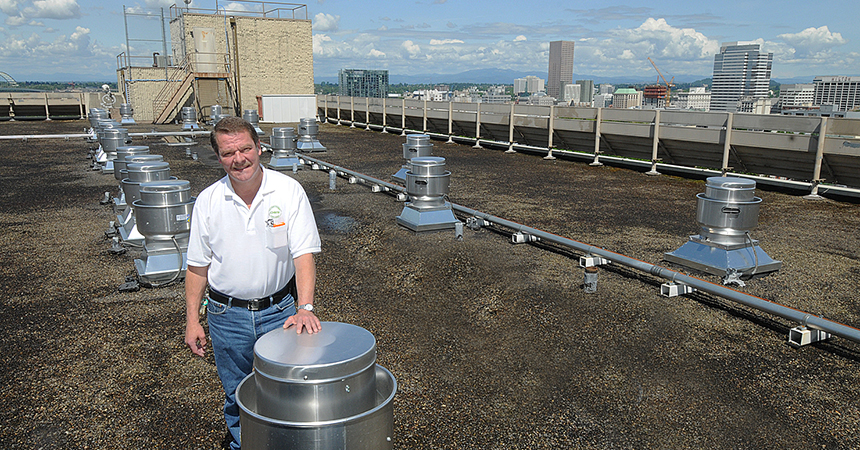
The 25 ventilation exhaust fans on the roof of Goose Hollow Tower, a 70,500-square-foot college housing apartment building in downtown Portland, were no longer doing their job. Students in the building’s 221 apartments repeatedly complained of stagnant air and heating costs. Maintenance personnel from management company College Housing Northwest were frequently on the roof performing maintenance, such as replacing belts and repacking bearings on the centrifugal fans.
College Housing Northwest asked Energy Trust to prepare a technical analysis on retrofitting the ventilation system, which dated back to the building’s construction in 1970. The study determined that the existing 1/4-to-1/3-horsepower fans were running continuously, drawing air from exhaust vents in each unit’s kitchen and bathroom into a vertical stack that ran from the first floor of the building to the rooftop. Much of the air that tenants were paying to heat was literally going up and out the building.
“With Energy Trust’s help, we decommissioned the existing fans and installed 25 new energy-efficient, direct-drives, dual-speed fans that use our existing ductwork,” said Jeff Hart, senior maintenance specialist, College Housing Northwest. “Energy Trust helped us find a qualified contractor to do the work, and gave us a cash incentive of $18,925.”
The new 1/4-horsepower fans operate on a programmed schedule that calls for 100 percent ventilation during typical cooking and bathing hours and only 60 percent at other times, improving indoor air quality by providing stronger ventilation during peak times. The improved fan efficiency and decreased fan speed for part of the day reduce fan energy use as well as noise. And the retrofit delivers an estimated $12,000 per year in heating cost savings—all of which goes to the student residents.
The property manager can now advertise low heating costs and other project benefits to potential new tenants, and save money by performing less frequent maintenance. As Jeff Hart put it, “The direct-drive fans have sealed bearings and are much simpler. Now, we only need to be up on that roof about once every quarter.”
